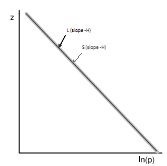Reference no: EM133242167
Question 1. Draw an adiabat and an isotherm in a (p, v) diagram, explain why they differ and why the adiabat is steeper than the isotherm (telling me that γ > 1 is not enough! Here I am looking for a physical explanation!).
Question 2. Show that the Brunt-Vaisala frequency can be expressed in terms of the potential temperature vertical profile as N2 = g/θ0.dθ/dz
Question 3. T is 3 K cooler 30 km to the north of a particular point, and the wind is from the north at 12 ms-1. The air is being heated by the net of absorbed and emitted radiation at a rate of 0.3 m2s-3. What is the local rate of change of temperature? (Assume the motion is along a surface of constant pressure).
Question 4. Consider an atmosphere in hydrostatic equilibrium with uniform potential temperature (i.e., an isentropic atmosphere). Find how pressure varies with height. In particular, show that such an atmosphere has a discrete top (where p = 0) at height RT0/(kg) with k = R/cp and T0 is the temperature at the reference pressure p0 = 1000 mbar. Compute the height of the discrete top, choosing a reasonable value for T0. Also compute the heights at which p reduces to 500, 300 and 100 hPa..
Question 5. Let's consider an air parcel at T = 285K and p = 1000 mb. What is the potential temperature θ of the parcel? If the parcel is being lifted adiabatically, what will its temperature T be at p = 500 mb? And at p = 200 mb?
Question 6. The pressure and temperature at the levels at which commercial jets usually fly are T = -60°C, p = 200 mb. What is the potential temperature of the air at these levels? What does this mean for how airplanes pressurize their cabin? Could they pressurize it adiabatically to 1 bar?
Question 7. The sea breeze is a light wind blowing from the sea as the result of a temperature difference between land and sea. During the day, the land surface is heated to a higher temperature than the sea. This difference is primarily due to the larger heat capacity of the sea. Consider a coastline with initially the same atmospheric temperatures and pressures over land (L) and over sea (S); see diagram below. Assume that there is initially no wind.
(a) As the air warms up on a sunny day, how do the scale heights change? Sketch the new vertical profiles over land and over sea. Why does this drive the high-altitude flow from land to sea?
(b) As a result of this high-altitude wind, the mass of the air column over land decreases. How does this affect the surface pressure? Again, sketch the pressure profiles over land and over sea. What do you infer about the direction of the surface wind? Can you identify a circulation cell resulting from the surface and high-altitude winds and compensating vertical motions?
(c) Explain how the daytime sea breeze turns into a nighttime land breeze.

Figure 1: Initial state for Problem 6: equal temperature and pressure over land and sea, i.e.: TL = TS and PL = PS. Pressure profiles over sea (grey) and over land (black) are the same.
Question 8. Observations show that over the Sahara desert, air continuously subsides. Consider an air parcel subsiding in this region, where the environmental temperature Te de- creases with height at the constant rate of 7 K km-1.
(a) Suppose the air parcel leaves height z with the environmental tem- perature. Assuming the displacement to be adiabatic, show that after a time δt, the parcel is warmer than its environment by an amount wSδt, where w is the subsidence velocity and S = dTe/dz + g/cp. (Note that S is a measure of the static stability of the environment; it expresses the departure of the atmospheric lapse rate from the adiabatic value). What is the value of S, given the given environmental lapse rate?
(b) Suppose now that the displacement is not adiabiatic, but that the parcel cools radiatively at such a rate that its temperature is always the same as its environment. Show that the radiative rate of energy loss per unit volume must be ρcpwS, and hence that the net radiative loss to space per unit horizontal area is
∞ ps
∫ ρcpwSdz = cp/g ∫wSdp
g 0
(c) Radiative measurements show that over Sahara, energy is being lost at a net, annually averaged rate of 20 W m-2. Estimate the vertically-averaged and annually averaged subsidence velocity (Hint: use the answers you got in (a) and (b) to compute the vertically-averaged w).